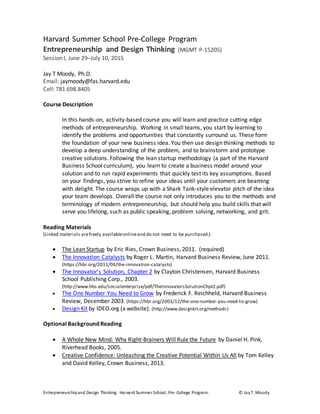
Syllabus - Entrepreneurship and Design Thinking
- 1. Entrepreneurshipand Design Thinking. Harvard SummerSchool, Pre -College Program. © JayT. Moody Harvard Summer School Pre-College Program Entrepreneurship and Design Thinking (MGMT P-15205) Session I, June 29–July 10, 2015 Jay T Moody, Ph.D. Email: jaymoody@fas.harvard.edu Cell: 781.698.8405 Course Description In this hands-on, activity-based course you will learn and practice cutting edge methods of entrepreneurship. Working in small teams, you start by learning to identify the problems and opportunities that constantly surround us. These form the foundation of your new business idea. You then use design thinking methods to develop a deep understanding of the problem, and to brainstorm and prototype creative solutions. Following the lean startup methodology (a part of the Harvard Business School curriculum), you learn to create a business model around your solution and to run rapid experiments that quickly test its key assumptions. Based on your findings, you strive to refine your ideas until your customers are beaming with delight. The course wraps up with a Shark Tank-style elevator pitch of the idea your team develops. Overall the course not only introduces you to the methods and terminology of modern entrepreneurship, but should help you build skills that will serve you lifelong, such as public speaking, problem solving, networking, and grit. Reading Materials (Linked materials arefreely availableonlineand do not need to be purchased.) The Lean Startup by Eric Ries, Crown Business, 2011. (required) The Innovation Catalysts by Roger L. Martin, Harvard Business Review, June 2011. (https://hbr.org/2011/06/the-innovation-catalysts) The Innovator’s Solution, Chapter 2 by Clayton Christensen, Harvard Business School Publishing Corp., 2003. (http://www.hbs.edu/socialenterprise/pdf/TheInnovatorsSolutionChpt2.pdf) The One Number You Need to Grow by Frederick F. Reichheld, Harvard Business Review, December 2003. (https://hbr.org/2003/12/the-one-number-you-need-to-grow) Design Kit by IDEO.org (a website). (http://www.designkit.org/methods) Optional Background Reading A Whole New Mind: Why Right-Brainers Will Rule the Future by Daniel H. Pink, Riverhead Books, 2005. Creative Confidence: Unleashing the Creative Potential Within Us All by Tom Kelley and David Kelley, Crown Business, 2013.
- 2. Entrepreneurshipand Design Thinking. Harvard SummerSchool, Pre -College Program. © JayT. Moody Expectations of Students Entrepreneurship and Design Thinking are participatory activities. Much like soccer or tennis or piano or violin, they are not learned only by reading a book, but also by acting and doing, trying and failing, and trying again. Students should come prepared to participate. To receive a strong evaluation, students must: o participate actively, o complete assignments and readings thoroughly and on-time, o maintain a thorough “E-log” (entrepreneur log) that demonstrates taking initiative (not just doing what you are told) to develop a stronger business, and records problems and ideas daily, and o deliver a well-organized, persuasive business pitch (or two or three). Course Outline (Caveat: Entrepreneurship always follows a crooked path! We will adaptas needed.) 1. Introductions to Entrepreneurship, Design Thinking, and each other. Practice finding business problems by taking an empathetic view: see what others miss. Social entrepreneurship and the Triple Bottom Line. How to record ideas, actions, and inspiration in the E-log. Practice changing the world through the meme exercise. 2. Going broad then getting narrow. Introduction to Fun Theory. Brainstorming methods and practice – how to push the envelope. Using a 2X2 to narrow the focus. Harvard Business Review on Intuit’s Innovation Catalyst program. Meme progress reports. Continued collection of problems and ideas in the E-log. 3. Lean Startup theory and practice. Overview of the Business Model Canvas and the NEXT Decision Tool. First pitches: initial business ideas. Idea selection and team formation. Distinguishing a Vision from an Idea. Clarifying your idea: Customer, Problem, Solution. Meme exercise results. Continued recording in E-log. 4. Isolating assumptions and designing experiments. Embracing ignorance: Know what you don’t know. Finding your Leap of Faith. Get smart fast vs. get big fast. The power of prototyping. Avoiding the say-do problem. Overview of experimental methods. Recording predictions for maximum learning. Running first experiments. E-log updates. 5. Innovation accounting and validated learning. From experiments to learning. Pivot or persevere? Keeping the vision in focus. Second pitch round: the current state of your start-up. E-log updates.
- 3. Entrepreneurshipand Design Thinking. Harvard SummerSchool, Pre -College Program. © JayT. Moody 6. Iterating through the Build-Measure-Learn loop: round two. Using validated learning to set your priorities. Love metrics and the Net Promoter Score. Preparing the next experiment. Introduction to future thinking. E-log updates. 7. Progress and Presentations. Future thinking exercise review. Death by PowerPoint: How to give a compelling presentation. Sample elevator pitches. Compiling learnings and preparing pitches. E-log updates. 8. Putting on the polish. Time to bring your business and presentations to the next level. E-log updates. 9. Final Pitches! Put your best foot forward to convince the VCs that you deserve funding to take your idea to the next stage. 10. Review and celebrate. Bringing the two weeks together. Understanding the Innovator’s Dilemma. Turning your E-log into an asset for future growth. Final questions and thoughts.